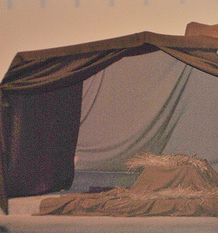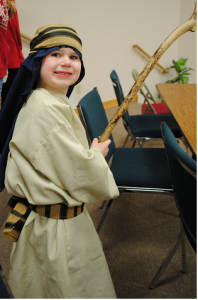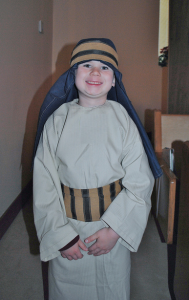 Any successful event begins with planning. The larger the event, the more planning needed to pull it off.
Any successful event begins with planning. The larger the event, the more planning needed to pull it off.
With a play, I spend two-thirds of my time planning all the details before the cast enters the rehearsal space. Knowing the framework helps me progress through rehearsals while using time wisely.
In part 1, planning the script, set, and properties forms the outward framework for the production. Then in part 2, developing the cast and crew, costumes and lighting conform to the framework for a cohesive whole.
After planning for so long, the time comes to execute those plans in rehearsals, through the program notes, and presented at the performance.
Rehearsals
With this performance, the action switched from the modern family to the traditional manager scene characters. Since all the practices occurred during school hours, I chose to work with either the modern family actors or the traditional manager scene characters up until performance week. During these rehearsals, we worked on the following:
Blocking. These are the entrances, exits, and movements on stage. By walking through the path they travel as they communicate their lines, the actors become more comfortable with their parts and confidence builds.
Line Interpretation. Assisting actors with attitude, understanding, and pronunciation of difficult words guides them to effectively communicate the script.
Characterization. Teaching the Wise Men to stand up straight while the Donkey should slump his shoulders due to his heavy burden is part of creating a character. Each actor is unique and brings a flavor to that character’s part. Encouraging play and experimenting results in some fabulous outcomes.
Motivation. Giving the actors the purpose behind their line prods them in the conflict, contrast, or amusement. Keeping the actors motivated in their communication brings intensity to an otherwise static performance.
Projection. In our performance space, we do not use microphones. To encourage the children to project their voices, I spend a full rehearsal concentrating on speaking to the ball field on the other side of the parking lot. Without screaming, the students work to increase their performance skills.
Tempo/Timing. Putting it all together with all the actors and the music usually produces many stops and starts. To get the performance to a smooth transitioning point, the tempo/timing rehearsal focuses on the transitions between the scenes. By reminding and guiding the actors, this rehearsal gets the production ready for full run practices.
Full Runs. To instill all the elements practiced, the final rehearsals are full runs including a dress rehearsal. Allowing the students to try-on their costumes helps to know where to adjust to accommodate angel wings and shepherd staffs. After these final adjustments, we are ready for performance evening.
Program
Though a program distributed to the attendees on the day of the performance can range from simple to complex, I chose to write director’s notes for the program. By including the scenes and words to the songs for the congregation, the list of cast and crew, and the director’s notes, the program for this production ended up taking 2 full 8.5”x11” sheets of paper. The finished program was a folded 4-page front and back booklet.
Since I enjoy writing the notes and including details for our parents, grandparents, and friends, my programs are lengthy. Some programs are as simple as listing the title and cast and crew. Depending on your time frame and the type of performance, your program length may change from simple to detailed.
Performance
By staying organized with each child’s costume labeled and set at his assigned place in the green room (for this performance the choir room), the children arrived, found their items, and enjoyed taking pictures while preparing for their performance. Knowing their entrances and exits, the cast performed well with seamless transitions.
All the children remembered their lines, their movements, and their properties. The planning resulted in a successful performance proclaiming the miraculous birth of Jesus Christ, the Savior of the world.
Whether you are directing a children’s program, a play for adults, or skits for a birthday party, spending the time planning before entering rehearsal will be using time wisely. Getting the framework in place keeps you focused to execute a successful event. Happy planning!
Question: What event is on your horizon? Please add your answer to the comments.






